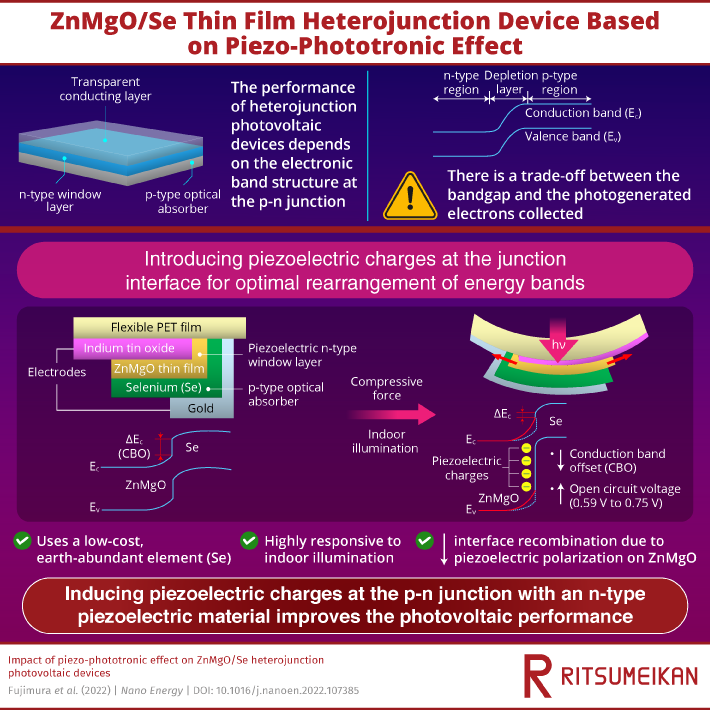Professor Zhong Lin Wang of the Georgia Institute of Technology demonstrated in 2010 that the use of piezoelectric materials (materials that generate electrical energy when mechanical strain is applied) could improve the performance of optoelectronic devices (devices that convert light into electricity like solar cells) or electricity into light as in light-emitting diodes or LEDs.
 Impact of piezo-phototronic effect on ZnMgO/Se heterojunction photovoltaic devices. Image Credit: Ritsumeikan University
Impact of piezo-phototronic effect on ZnMgO/Se heterojunction photovoltaic devices. Image Credit: Ritsumeikan University
By simultaneously bending the wire and subjecting it to a laser source, the research team was able to control the bandgap of ZnO and maximize the electrical characteristics of the nanowires using piezoelectric zinc oxide (ZnO) nanowires.
Their findings cleared the way for the development of new types of self-powered flexible electronic devices with piezoelectric and photoelectric capabilities.
In light of this, Ritsumeikan University researchers have invented a revolutionary thin-film flexible piezoelectric-photovoltaic device that can generate power only from interior lighting supplied by LEDs and compact fluorescent lights, according to a recent study.
Thin sheets of ZnMgO, an electron-rich n-type piezoelectric material, and selenium (Se), a low-cost, electron-deficient p-type material that can efficiently absorb indoor ambient light, were deposited on a flexible PET plastic film to create the device, which is paper-thin and just 10-mm long.
The researchers were able to construct the photovoltaic device using a totally dry approach, eliminating the need for chemical solutions, by employing ZnMgO as the piezoelectric material.
In this work, the piezo-phototronic effect was applied to ZnMgO/Se heterojunction photovoltaic devices for the first time.
Professor Taizo Kobayashi, Study Corresponding Author, Ritsumeikan University
His research is published in Volume 99 of the journal Nano Energy in August 2022, and it was made accessible online on May 18th, 2022.
When the two semiconducting materials were combined, they formed a p-n junction at the interface, allowing the device’s electrical band structure to be modified by bending it.
Kobayashi added, “When compressive strain is applied on the ZnMgO layer, a negatively polarized ZnMgO region is formed near the Se layer. This polarization decreases the conduction band offset at the interface of ZnMgO and Se layers.”
The researchers were able to solve one of the primary causes of poor solar cell performance, charge recombination, by adjusting the bandgap at the p-n junction. Light-excited electrons recombine with “holes,” or the vacancies left by electrons in this process, resulting in a loss of charge carriers that would otherwise create electricity.
The researchers were able to improve the open-circuit voltage (a measure of the usable charge carriers produced) from 0.59 V to 0.75 V by creating strain-induced polarization in the ZnMgO layer.
However, bending the device resulted in fractures forming in the electrode layer, lowering the current density and reducing the gadget’s ability to convert light into energy. Despite this, the researchers believe that the problem can be remedied with more durable materials like graphene.
“In the future, we will develop alternative transparent conducting electrodes that would be more durable against strain. For now, the fact that our paper was accepted by a journal as prestigious as Nano Energy provides a great opportunity for us to promote our research,” concluded Kobayashi.
Piezo-phototronics could become the technology of future thin-film solar cells if researchers continue with their efforts.
Journal Reference:
Fujimura, J., et al. (2022) Impact of piezo-phototronic effect on ZnMgO/Se heterojunction photovoltaic devices. Nano Energy. doi:10.1016/j.nanoen.2022.107385